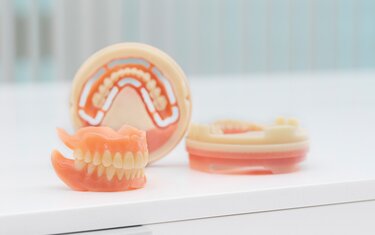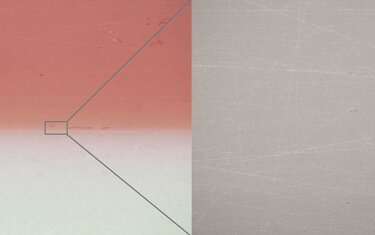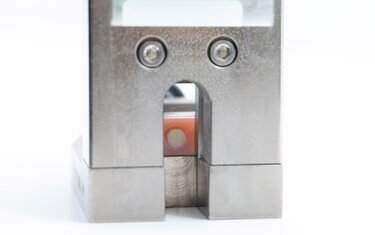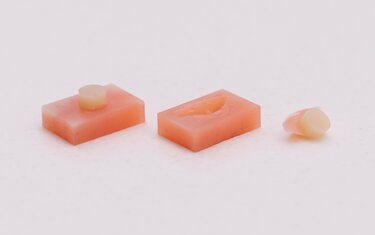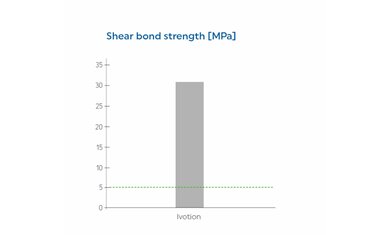A single disc made of both tooth and denture base material, for the complete fabrication of dentures in one uninterrupted milling process: that’s Ivotion. You might ask yourself: "How is that possible?" And: "Does that even work?" And apart from anything else: " Will the dentures be ˈstrongˈ enough in the long term?"
With the launch of Ivotion, a single disc for the fabrication of monolithic, complete dentures in in just one milling process, Ivoclar has taken another revolutionary step forward in the digital fabrication of removable dentures. Ivotion is an intelligent combination of high-grade proven tooth and denture base materials in a single disc of two colours, providing dental laboratories that use the digital workflow with an efficient and predictable monolithic solution. The key here is: A special geometry inside the disc, coupled with a homogeneous bond between its high-grade PMMA materials, ensures reliable results that are simple to produce and offer long-term stability.
Dentures from one disc made of two materials. How reliable are these dentures really?
Numerous studies and long-term experience have shown that denture base material and the bond between the denture base and teeth (tooth loss) present the two biggest "weaknesses" of removable dentures. For example, a study conducted in 2010 found that removable dentures generally offer a very long lifespan (on average 15.8 years for the lower jaw and 19.4 years for the upper jaw). However, over a monitoring period from 1984 to 2009, denture base fractures occurred in 5.8% of patients, while another 5.8% of patients (two sets of dentures) and 10.9% of patients (one set of dentures) even reported a loss of ‘teeth’ (Dorner, S., Zeman, F., Koller, M., Lang, R., Handel, G., and Behr, M. (2010) Clinical performance of complete dentures: a retrospective study, Int J Prosthodont 23, 410-417).
High-quality denture base material and a strong bond with the tooth material are therefore of critical importance. Ivotion is an excellent solution to both problems, with an approach that combines two different materials in a single disc and requires just a single milling process.
The tooth and gingiva materials developed for Ivotion are the result of intensive research work. They build on combinations of established and clinically proven products. This means that they are guaranteed suitable for use in permanent restorations in complete denture prosthetics.
As a result, the tooth and gingiva materials not only meet the internal quality criteria of Ivoclar Vivadent AG, which are already very stringent and rigorous, but they also comply with the standards applicable for similar products.
Material testing was carried out based on[1] EN ISO 10477:2018 (tooth material) and EN ISO 20795-1:2013 (gingiva material).
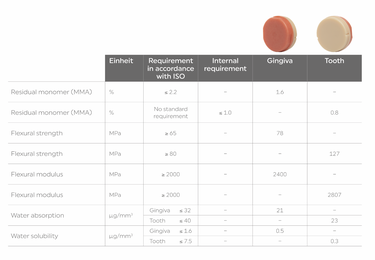
Table: Illustration of the values measured on the basis of the respective standards ISO 10477:2018 (tooth material) and ISO 20795-1:2013 (gingiva material). The results demonstrate compliance with the requirements for restoration with permanent dentures. The optimized fracture resistance of the gingiva resin is particularly noteworthy. This means increased stability with regard to crack initiation (Kmax) and greater resistance (Wf) when defects occur. The risk of fractures and related repairs is reduced as a result.
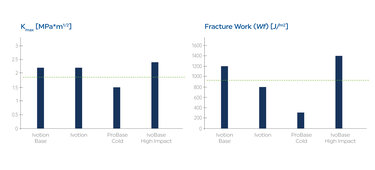
Diagram 1 and 2: Fracture toughness properties Kmax and FW based on ISO 20795-1:2013, internal test. Sample values are shown. The green line indicates the minimum requirements (Kmax ≥1.9 MPa*m1/2, Wf ≥900 J/m2) for high-impact denture materials in accordance with the standard. The diagrams compare the fracture toughness values of Ivotion with those of conventional and digital products from Ivoclar for the fabrication of denture bases.
This is what makes Ivotion so unique: The bond between the tooth and gingiva material is established without using an adhesive additional component. Both materials are polymerized together in a single process step, comparable with the production of multi-layer prefabricated teeth for removable dentures. In other words, this is a direct chemical bond. As a result, the Ivotion disc can be termed a monolithic material. The material transition runs precisely through the entire Shell Geometry, specific to the respective location. This attribute is critical to the esthetics of the dentures milled from it.
Shear bond strength (or shear bond strength test) is a widely established method that is used in particular to demonstrate bonding in the case of crown and bridge materials as well as tooth and denture resins with characterization materials. Accordingly, it also played a key role in the development of the entire Ivotion Denture System.
The standard is met if at least a shear bond strength value of 5 MPa is achieved. An additional internal requirement is a cohesive fracture pattern. This means that the fracture occurs in the material rather than in the bonding area. High measured values and fully cohesive fractures are evidence of a strong material bond.
In this test, material in the form of a cylinder (∅ 5 × 6 mm) is attached to a base plate measuring 5 × 10 × 15 mm and polymerized, in accordance with the standard. A load is then applied to the polymerized cylinder in a standardized device until they fracture. The load to fracture and the cross-section of the cylinder are then used to calculate the bond strength (shear bond strength in MPa). In addition, the fracture pattern is evaluated and classified into cohesive and adhesive fractures. In the case of Ivotion, the test can only be carried out in reference to the ISO standard, as the test specimens are sourced directly from the milling blank (see Figure 4).
On average, the Ivotion samples achieved values of over 30 MPa while demonstrating only cohesive fracture patterns. The requirements in terms of material bonding are therefore clearly met.
Ivotion is the key to amazing efficiency
Ivotion combines both tooth and denture base material in one disc. Digital dentures made of Ivotion are milled from one disc in a single uninterrupted milling process without time-consuming manual working steps.
Ivotion from Ivoclar is an intelligent combination of high-grade proven tooth and denture base materials. The monolithic disc contains the unique Shell Geometry, a three-dimensional tooth and dental arch geometry based on real denture data that defines the transition between the tooth and denture base materials. With the Full Denture Module in the 3Shape Dental System, dentures can be customized to suit the needs of the individual patient. If Ivotion is used, there is no longer any need to bond the denture teeth to the denture base, reducing potential problem areas. The PMMA material also impresses with its optimized fracture resistance.
True to the motto: "Design. Mill. Finish.", complete dentures are fabricated as part of a fast, uninterrupted milling process in a PrograMill milling machine. After the milling process, only polishing is required to finish them. Ivotion is the key to impressive efficiency: it allows patient-specific, monolithic complete dentures to be produced in a seamless workflow with just a few manual steps.
Roger Frei is a Research Associate in the Research and Development team at Ivoclar Vivadent AG. With 17 years of experience in the development of innovative materials and systems for removable dentures, particularly denture resins, he is an experienced source of expertise. In addition to optimization of the conventional prosthetic product range, the focus of his work over the last few years has been the enhancement of products and materials for the digital fabrication of removable dentures.
[1] The valid versions of the EN ISO standards (as of 2020) do not provide for the direct classification/categorization of prefabricated milling blanks. Accordingly, the tests can only be carried out in reference to the standard. The specified material requirements, however, remain unchanged.
